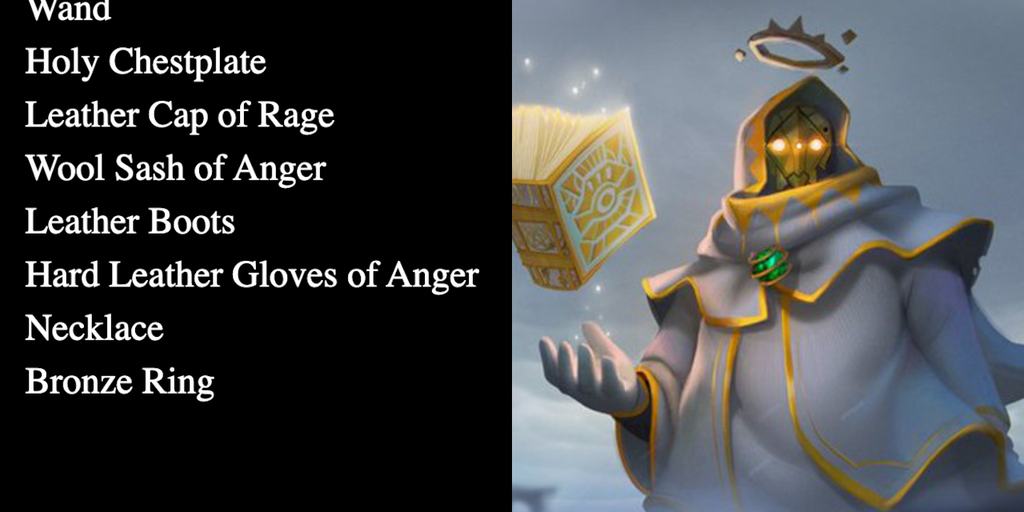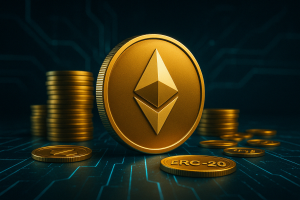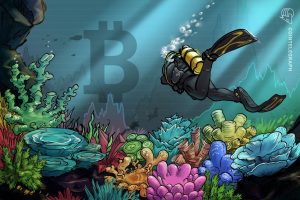Loot, One Year Later: The NFT Hype Is Dead—But ‘Lootverse’ Hope Lives On
3 years ago CryptoExpert
It started with a tweet.
Dom Hofmann, well known in tech circles as the creator of video app Vine, had released a free mint for an Ethereum NFT with nothing more than white text on a black background. Loot (for Adventurers) spanned 8,000 tokenized “bags” of fantasy weapons and items; “randomized adventurer gear,” in Hofmann’s words. It minted out within a few hours.
To some, it represented the absurdity of the NFT boom. Who would spend ETH on gas fees—which can spike into the hundreds or thousands of dollars—to mint such a thing? But to others, Loot was a revolutionary step forward: the open-source bones of a bottom-up, community-driven intellectual property, with user-owned games and media that correspond and collectively strengthen each other.
Hype skyrocketed—but it didn’t last. While the average sale price for a Loot NFT soared to over 21 ETH, or about $84,000 at the time, the speculative frenzy soon faded. Prices fell, volume slowed, and the buzz quieted in the weeks that followed its launch. But Loot’s creative spark was real.
A small community of creators continue to use the NFTs as “scaffolding” to inspire an array of games and more. One year after the hysteria, the builders of the “Lootverse” told Decrypt about building in the wake of deflated hype, why they believe it’s the start of a creative revolution, and how “Loot 2” might accelerate it.
‘A paradigm shift’
Hofmann previously co-founded Vine and other tech startups before catching the Web3 bug. He launched the NFT project Blitmap, co-created Nouns, and is now building on-chain games with Sup. But Loot proved to be a singular sensation.
It was an experiment, and he treated it as such. He didn’t charge any money to mint one of the 7,777 publicly available NFTs (the other 223 were reserved for Hofmann), aside from the Ethereum network’s own gas fee—an obligatory transaction fee paid to the network—nor did he attach a creator royalty to secondary sales. Hofmann told Decrypt recently that “it felt wrong” to ask for money or to expect royalties for such a venture.
And the NFTs could only be minted directly from the smart contract itself—code that performs set instructions and powers NFTs and decentralized apps—making it less accessible to casual users and crypto newcomers. That was an intentional level of friction meant to attract experienced users, he said, or those willing to push through barriers.
“Those decisions were intended as a way to reinforce the bottom-up and communal spirit of the project,” Hofmann said.
Loot was kept as simple as possible so that others could build whatever they wanted on top of them. Each NFT contained a simple list of Dungeons & Dragons-esque items—Bronze Ring, for example, or a “Grim Shout” Grave Wand of Skill +1—with no visual component or listed stats. Both were “intentionally omitted for others to interpret,” Hofmann tweeted at launch.
While Loot’s lists had some scratching their heads, many Web3 enthusiasts breathlessly praised its potential as a composable, blockchain-powered baseline for future fantasy games and media. What if Loot’s bags of gear could lead to characters, worlds, and stories that all start from the same seeds and collectively grow in time?
Loot had nobody in charge, no firm to unilaterally make decisions about the IP—in other words, no gatekeepers. It perfectly fit the permissionless crypto vibe; a public good for collaborators to treat as a narrative starting point. “Feel free to use Loot in any way you want,” the website read.
Software engineer Thanakron Tandavas called it “a paradigm shift in NFT space” at launch, exalting its bottom-up design to encourage community-led building. PartyBid creator John Palmer likened its impact to NFT icon CryptoPunks, stating, “There was Before Loot and now there’s After Loot.” Even Ethereum creator Vitalik Buterin praised Loot’s open-ended approach.
Web3 creators took the cue. Within days, people were sharing their own artwork around Loot, along with guilds, music, lore, companion animals, and quite a bit more. SyndicateDAO co-founder Will Papper even launched an Adventure Gold (AGLD) currency for the ecosystem and let Loot holders claim 10,000 tokens—worth $77,000 per NFT bag, at peak.
It all helped fuel a brief, but explosive market boom around the NFTs, ultimately yielding about $280 million worth of secondary trading volume to date, per data from CryptoSlam. One NFT bag sold for over $1.4 million worth of ETH last October. Derivatives and knockoffs followed. The Loot revolution appeared to be off to a fast start.
‘Boom and bust’
But the hype didn’t last for long. Prices for Loot on secondary marketplaces fell swiftly as the NFT market itself cooled last fall amid a dip in Ethereum’s value. Demand fell off a cliff, from $221 million in trading volume in September 2021 to under $12 million in October, per data from CryptoSlam—a 95% collapse.
People who spent tens of thousands of dollars on a single Loot NFT struggled to find takers at a fraction of the price. Some speculators hoping for profits on a quick flip were instead wrecked by Loot’s brief moment in the NFT spotlight. Today, the floor price—or cheapest available NFT on a marketplace—for Loot sits at just 0.93 ETH, or under $1,600.
It wasn’t just individual investors, either. Kyle Samani, managing partner of investment firm Multicoin Capital, boasted on Twitter of buying “8 figures of Loot” in September 2021, adding a cheeky “AMA,” or “ask me anything,” to his tweet. It was Multicoin’s first NFT investment, and Samani justified it by saying that Loot was “the first investable crypto-native game.”
Months later, someone asked what came of that investment. Samani admitted that it was “down 95%,” but added, “Being willing to lose 100% of capital at risk is very important to our long-term success.” Multicoin Capital declined to comment for this story.
Down 95%
— Composability Kyle (@KyleSamani) May 4, 2022
Ultimately, the rapid boom-and-bust speculation cycle cast a pall on the Loot project. The tangible excitement over the open-source, composable building blocks was largely eclipsed by the outlandish sums that some paid for the NFTs—and how much money some buyers then considered lost when the market for Loot evaporated.
Hofmann himself never promised anything to NFT buyers. However, given the hype cycle, expectations ran high. Some wondered aloud where all of the Loot-based games were. Creative projects can take considerable time to execute, but that doesn’t comport with the fast-evolving NFT space and impatient investors’ expectations of rapid returns.
“Hype can get to a place where it begins to reinforce itself, and can find itself existing outside of the core concept and actual work being done,” Hofmann told Decrypt, reflecting on the moment. “Timelines and expectations can get warped, and that can cause some noise and friction.”
Some of the people who embraced Loot’s Web3-native promise early on continued to build after the hype faded. However, the perception of Loot as a failed project created challenges in bringing in new collaborators and getting their extensions and projects off the ground.
“Loot became incredibly popular and then incredibly unpopular,” said pseudonymous builder Threepwave, who created Loot dungeon map project Crypts & Caverns and is a developer on Lootverse game, Realms. “Some of my friends were like, ‘What are you doing? You’re crazy. That Loot thing lost me a lot of money.’ It left a bad taste in people’s mouths.”
Pseudonymous Realms founder LordOfAFew cited Loot’s “boom and bust cycle,” and admitted that there are fewer creators entering the space since last year’s launch. Still, he said that many builders just kept plugging away despite the declining NFT prices and dimming spotlight. “That didn’t really faze them at all,” he claimed.
Into the Lootverse
One year later, we’re starting to see significant progress on games and storytelling initiatives born from Loot’s open-ended prompt. Some are built atop the original Ethereum NFTs and interact directly with them, while others are inspired by the premise but use their own NFTs. Creators collectively call it the Lootverse.
“What’s going on inside of Loot is a bunch of builders working together to experiment with the rough edges of what’s possible with the blockchain, and build these composable building blocks that go with each other in a playful way,” explained the pseudonymous Timshel, co-creator of the Loot-based Genesis Project who operates The Loot Foundation website to encourage further building.
We’re building the Lootverse *together*
From low fidelity to high fidelity every week
A fictional fantasy universe, with characters, places, artifacts, conflicts, stories, histories, games, art, music, and more pic.twitter.com/wVW2IM1k47
— 🔮TIMSHΞL (@TimshelXYZ) June 2, 2022
Beyond the initial experimental derivatives from various creators, Timshel and fellow builders LootHero and Peter Watts discovered a hidden classification and ratings system within Loot’s smart contract code—data that could help develop more consistent lore around the bags.
That led to Genesis Loot, or bags said to be held by earlier adventurers in the community-driven Loot lore, and a Lore Development Kit that provides guidelines that builders can tap into (if they please). Lootverse NFT project Banners, meanwhile, claims to provide a “society and politics layer for Loot.”
Crypts & Caverns is a key bit of on-chain Lootverse infrastructure that provides dungeon maps for builders to incorporate into games and apps, potentially saving a time-intensive step. “Now you’re pretty far along towards making a decent dungeon-crawling game or exploration game at minimum,” Threepwave told Decrypt.
Loot MMO is one of those games utilizing the maps, and it’s a polished-looking fantasy role-player running on the Unreal Engine—the same as many of today’s biggest games—via Manticore Games’ Core platform. The game utilizes players’ owned Loot NFT, including the original bags, More Loot expansion bags, and various community projects.
Meanwhile, Realms: Eternum is a resource-management game that runs on the Ethereum scaling network StarkNet. It’s well along in development and nearing a broader testing phase. LordOfAFew demoed the game to Decrypt, showcasing a menu-driven affair with military units, buildings, farming, and other variables that players control before raiding online opponents.
Another intriguing gaming project in the Lootverse is HyperLoot, which uses Loot bags to visualize a 3D avatar that can potentially be used across various game worlds. It’s a “second-layer visual building block” on top of Loot NFTs, Tandavas told Decrypt, and he’s using it to create a combat game called CC0 Wars with characters from Nouns and other projects with “no rights reserved” Creative Commons CC0 licenses.
Loot’s community isn’t just generating games and related infrastructure, however. It’s also spawning stories and pushing the bounds of on-chain storytelling. Timshel’s Open Quill collective is compiling a book of Loot-inspired stories that will be released both as a physical tome and as an NFT, with the ability to read stories via the Ethereum blockchain.
The NFT, called The Eye (for Adventurers), mints this weekend. But it’s more than just a book of Loot-based tales. The NFT also serves as a key to publish work via The Librarium, a new Ethereum platform for on-chain storytelling. Loot birthed the Lootverse, and now the Lootverse could help break other ground in Web3 creation.
“It’s very inspiring and beyond anything I could have imagined,” said Hofmann of the expanding Lootverse. “I’ve been lucky enough to build things that were adopted by creators in the past, but this one felt and continues to feel different. So many people I respect immensely are involved in or adjacent to the project.”
The future of Loot
The Lootverse faces challenges that go beyond the coordination hiccups that affect many decentralized communities. One hurdle, Threepwave said, is the lack of a strong hand guiding infrastructure development and collaboration. But the bigger issue around Loot, multiple builders told Decrypt, has to do with incentives to fuel further growth.
Loot was released for free, so there was no primary sale revenue—and no initial royalty was set, which meant no gradual funds flowing into a community-owned DAO treasury controlled by NFT holders. Builders can create and sell their own NFTs to fund Loot-inspired projects, as some have, but the market for those has thinned.
Timshel described the lack of funding in the first year as “a feature, not a bug,” as it ensured that builders were passionate about the cause and creating in an economical fashion. But the Lootverse may only grow so much without financial propellant to ensure that creators can invest their time and be rewarded for what they’re contributing to the ecosystem.
After the initial Loot buzz faded, NFT holders voted to have a 5% royalty added to secondary sales, and that has helped fuel a couple small rounds of grants, including a Gitcoin round for Loot-based projects. They’re relatively modest awards—after all, the royalty was added after the majority of high-value Loot sales, and relatively little ETH is coming into the DAO.
Guess what folks? We’ve got another ecosystem to announce! Introducing…
The Lootverse Round! 💫
This $130k round funded by @lootproject aims to support projects directly advancing the Loot ecosystem, providing an invitation for a new cohort to build on ETH.
Let’s dive in👇1/
— Gitcoin (:D , :D) 🤖 🌍 (@gitcoin) June 8, 2022
How can Loot’s community—which spans about 150 active builders, Threepwave estimated—fix that funding problem? It could come, unexpectedly, from “Loot 2.”
Timshel said that “core Loot leadership” (including Hofmann) are working on a proposed upgraded NFT collection that would help solve the value accrual issue and reward creators for their input. Timshel described it as “a Loot 2.0 upgrade to Loot, like from Windows 95 to Windows XP.”
The next-gen Loot NFT project, as currently proposed, would seek to provide an “upgraded foundation for the Lootverse,” said Timshel, and the new Loot bags would be similar—albeit “more dynamic and more alive.” He pointed to Hofmann’s “Just lore” tweet from April, which contained a passage that hinted at grand adventures contained within a bag’s contents.
“The bag is actually this infinite container that contains a universe, and each bag is a little more alive than just like a bag of crap on the ground. It’s almost like a fantasy wallet that contains your stuff,” Timshel explained of the premise. He added that the “wallet” could also contain media, characters, history, passes, gear, and more.
In other words, it sounds a bit like an access pass to the budding Lootverse. And for builders who are bringing that space to life, a revised rollout and model would allow the DAO behind the project to offer Loot NFTs as a form of equity (or payment) in exchange for services that benefit the wider Loot community.
“Now you’re an owner,” Timshel said of NFT grants. “Now you want to come do this with us.”
Whether “Loot 2” ultimately comes to life remains to be seen, and there may be other solutions to solve the funding hurdle. Still, the Lootverse is taking shape, and the polished products that some expected last year are about to see the light of day. Builders told Decrypt that they are confident that momentum will only grow from here.
“It really does feel like a grand new fantasy world is being built and nurtured by its community,” said Hofmann.












